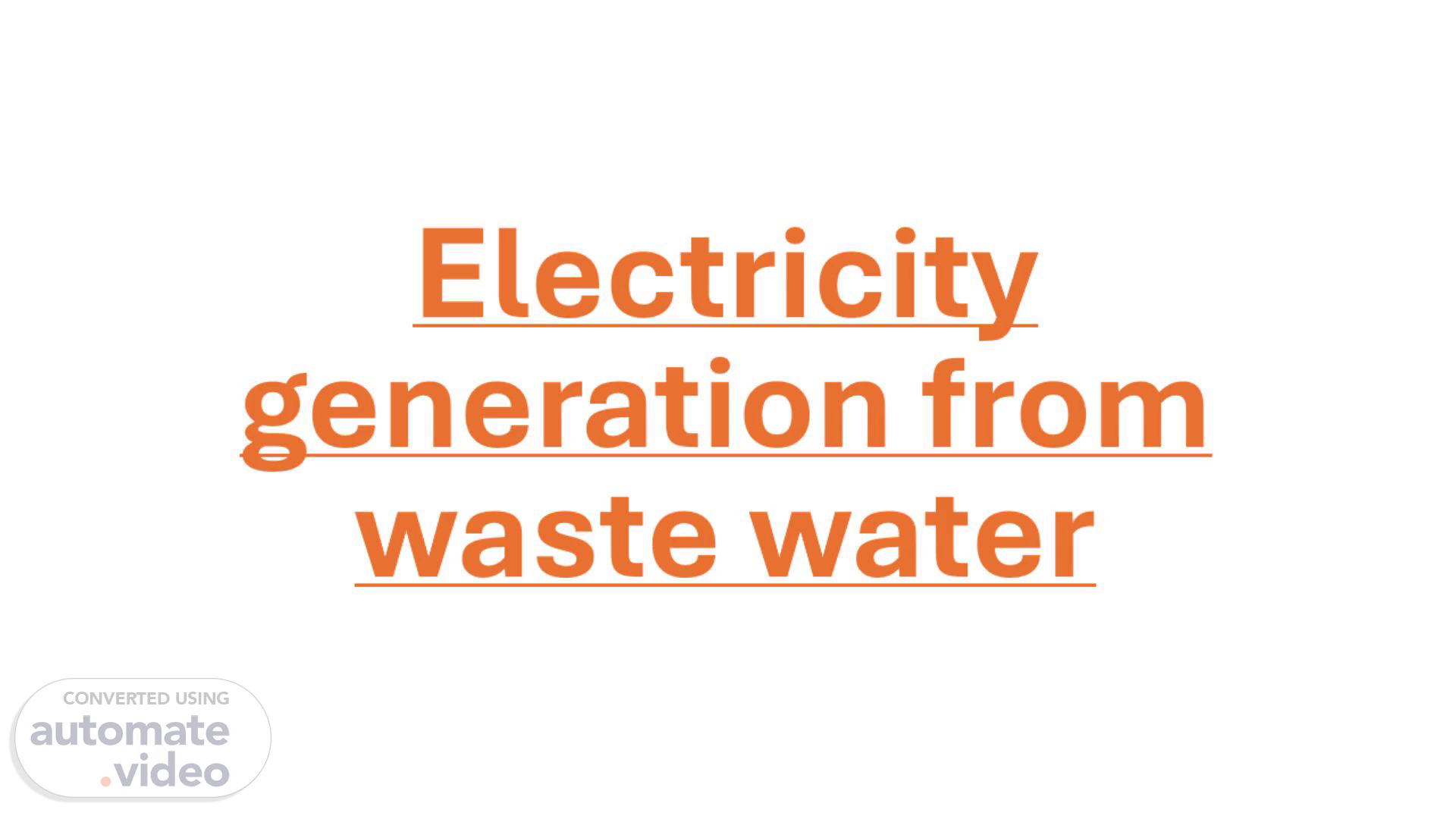
PowerPoint Presentation
Scene 1 (0s)
[Audio] Electricity generation from waste water. Electricity generation from waste water.
Scene 2 (6s)
[Audio] Abstarct In the last decades , the microbial fuel cell has increased great opportunity as an alternative energy source through electrochemical process for producing bio-energy.MFC has been involved in anode and cathode for electric energy generation from organic ingredients. Such as bacteria in waste water treatment. In this review, we descussed the different types of MfC materials with various integration, in addition, it includes the gainful bio compatible and exceedingly constant electrode materials with enhanced MFC performance..
Scene 3 (42s)
[Audio] Following the review, expansion in membrane materials such as hydrocarbon polymer,per fluorinated polymer, organic –organic hybrid polymer, ceramics, organic –inorganic hybrid composite and bio polymer membranes are clarified detail . In this paper , also highlighted the application of MFC technology and the methods used in MFC in electricity production..
Scene 4 (1m 6s)
[Audio] Introduction (MFC) The Microbial fuel consists of anode and cathode combination, proton exchange membrane and electcal components. MFC is an alternative and sustainable skill for direct conversation method in organic matter content for waste water treatment. Reduction of non – renewable energy incomes organic or inorganic wilds can deliver an efficient resource of solving energy and environmental difficulties concurrently. MFC expertise has concerned an improved number of scholars in current ages because of its potential also particularly for bio-energy creation and waste water treatment. At present MFC can harvest enough current to small power electronic device used for short period..
Scene 5 (1m 56s)
[Audio] The impartial of this paper was to appraisal on the recent microbiology information in electricity production. The materials and devices are used to shape the technology and application and the application and limitation and the limitation for MFC expertise also emphasized. The benefits of MFC shown in figure ..
Scene 6 (2m 17s)
[Audio] MFC working MFC is comprised of anode and cathode working with volum100ml in each chamber by separating a proton exchange membrane. The membrane is inserted in distilled water at 80 – 90C .When the membrane is washed and stored in deionized water . Anode and cathode have the inlet ,outlet holes to change the solution of anolyte and catolyt and they are the constant in anaerobic and aerobic conditions the nanoparticles coated and uncoated carbon papers of anode and cathode are placed 2cm away from either side of the membrane. To remove the dissolved oxygen and nitrogen is purged to the chamber..
Scene 7 (2m 57s)
[Audio] Single or duel chamber Microbial fuel Cell are mostly functional by researchers. In a single chamber mediaterless MFC were proficient for removing COD then BOD. Microbial fuel cell are oxidized and decrease organic molecules . Adaptation of sunshine energy in electricity relies on a development known as electrical phenomenon impact. This is often the fundamental reason for manufacturing electricity because of electrical phenomenon impact. While the MFC operation the contact between the microbes and substrate are effective. Anode and cathode are swapped while voltage is decreased from its maximum open circuit potential. The settled down biomass was used in subsequent cycle after 24hrs after the reactor settled down..
Scene 8 (3m 48s)
[Audio] .
Scene 9 (3m 53s)
[Audio] . Waste to Energy Wastewater Process MFC: Generating Electricity on Site and Treating Wastewater Electricity Gujarat Vidyapith Bi resour Application -Fuer Composition of wastewater Reaction o I benzimidazole Water electrolysis 40 cov Anodic Chamber (Anaerobic) + 6 H20 6 24 24 e- Cath Odic 6 02 + 12 H20 -0.42V Total potential difference + 24 V +0.82V Reference Ahn Y, Logan BE. Effectiveness Of domestic wastewater treatment using microbial fuel cells at ambient and Bioresour Technol Lee Y, Nirmalakhandan N. Electricity production in microbial fuel Ceu fed with livestock Organic Solid 131 Sciarria Tp, Tenca A, D'Epitanio A, Mecheri B, Merlino G, M, etaL using olive mi" Wastewater to i mprove performance in producing electricity ti by u sing microbial fuel.
Scene 10 (4m 17s)
[Audio] . LIVI 6-L WI €1-01 12101 ooo'oo't-ooo'ost OOO'08't-OOO'09'€ 000'08-000'09 ooo'os'€ - ooo'ot'€ saadtm ueyptll JOO!O.1d Juott10J!nbou ley0Jev.N FOO .1noqe"1 aoetllmuyevv tlO!JOtUJSUOD 000'00'1) ISOO uopon.usuoo.
Scene 11 (4m 27s)
[Audio] Voltage generation. Voltage generation. Volta e 0.6 0.5 0.3 S 0.2 0.1 0.0 Time (days) Figure 2: Numbers of Days versus Voltage (V) of MFC..
Scene 12 (4m 41s)
[Audio] Current generation. Current generation. 28 Current (mA) 20 1.5 05 00 Time (days) Figure 4: Numbers of Days versus Current (mA) of MFC..
Scene 13 (4m 50s)
[Audio] Power generation. Power generation. 05 Power mw 0.4 Time (days) Figure 5: Number Day versus Power (mW) of MFC..
Scene 14 (4m 59s)
[Audio] BOD COD. BOD COD. 400 350 300 S 250 200 150 ¯ 100 Initial (m g/liter) Final (mg/liter) Parameters Figure 6: BOD (mg/L) of Sewage wastewater..
Scene 15 (5m 12s)
[Audio] BOD vs COD. BOD vs COD. Removal % 60 50 s 40 0 30 20 10 Parameters Figure 8: Removal (%) of BOD and COD of Sewage wastewater..
Scene 16 (5m 21s)
[Audio] Refference 1. R. Wu, C. Ma, and Z. Zhu, “Enzymatic electrosynthesis as an emerging electrochemical synthesis platform”, Current opinion in electrochemistry, Vol. 19, pp. 1 – 7, 2020. 2. L. Xu, Y. Zhao, K. A. Owusu, Z. Zhuang, Q. Liu, Z. Y. Wang, Z. Li, and L. Mai, “Hierarchical Nanowire Arrays as Three-Dimensional Fractal Nano bio interfaces for High Efficient Capture of Cancer Cells”, American Chemical Society,Vol.16, No.1, pp. 766-772, 2016. 3. N. Vishwakarma, A. Sharma, “Microbial fuel cells: novel microbial physiologies and engineering approaches”, Current Opinion in Biotechnology, Vol. 17, no. 3, pp. 327–332, 2008..